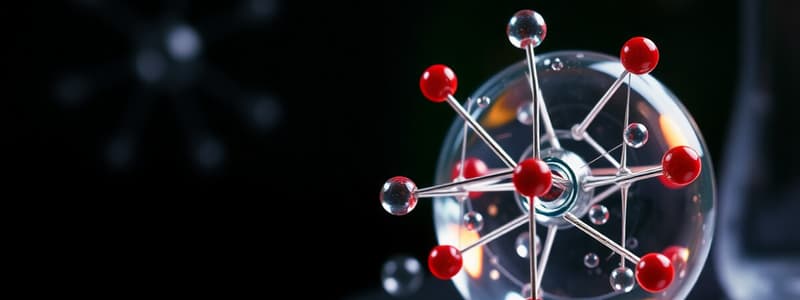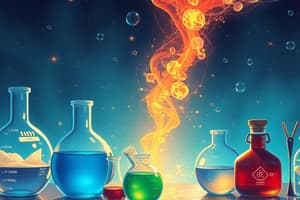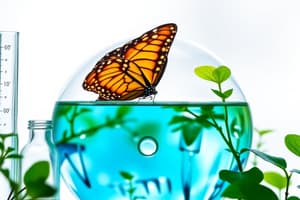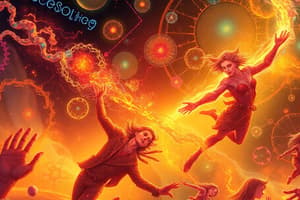Podcast
Questions and Answers
The atomic number of an atom is determined by the total number of protons and neutrons in its nucleus.
The atomic number of an atom is determined by the total number of protons and neutrons in its nucleus.
False (B)
In a controlled experiment, the control group receives the treatment being tested, while the experimental group does not.
In a controlled experiment, the control group receives the treatment being tested, while the experimental group does not.
False (B)
A tissue is a group of similar cells performing a specific function, while an organ is composed of different tissues working together.
A tissue is a group of similar cells performing a specific function, while an organ is composed of different tissues working together.
True (A)
Glycogen serves a structural role in plant cell walls, providing rigidity and support.
Glycogen serves a structural role in plant cell walls, providing rigidity and support.
A polar covalent bond involves the equal sharing of electrons between two atoms, resulting in no partial charges on the atoms.
A polar covalent bond involves the equal sharing of electrons between two atoms, resulting in no partial charges on the atoms.
During hydrolysis, water molecules are added to break the bonds between monomers in a polymer, while dehydration reactions remove water to form polymers.
During hydrolysis, water molecules are added to break the bonds between monomers in a polymer, while dehydration reactions remove water to form polymers.
Saturated fats contain multiple carbon-carbon double bonds, leading to a bent structure and lower melting point compared to unsaturated fats.
Saturated fats contain multiple carbon-carbon double bonds, leading to a bent structure and lower melting point compared to unsaturated fats.
The primary structure of a protein refers to the sequence of amino acids linked by peptide bonds, while the quaternary structure describes the overall three-dimensional arrangement of multiple polypeptide subunits.
The primary structure of a protein refers to the sequence of amino acids linked by peptide bonds, while the quaternary structure describes the overall three-dimensional arrangement of multiple polypeptide subunits.
If a solution has a higher concentration of hydroxide ions (OH-) compared to hydrogen ions (H+), it is considered acidic.
If a solution has a higher concentration of hydroxide ions (OH-) compared to hydrogen ions (H+), it is considered acidic.
In DNA, adenine (A) always pairs with guanine (G), and cytosine (C) always pairs with thymine (T).
In DNA, adenine (A) always pairs with guanine (G), and cytosine (C) always pairs with thymine (T).
The R-group, carboxyl group, and phosphate group are the common components found in all amino acids.
The R-group, carboxyl group, and phosphate group are the common components found in all amino acids.
Radioactive isotopes are not useful in medicine or paleontology due to their unstable nature.
Radioactive isotopes are not useful in medicine or paleontology due to their unstable nature.
Prokaryotic cells contain membrane-bound organelles such as a nucleus and mitochondria, similar to eukaryotic cells.
Prokaryotic cells contain membrane-bound organelles such as a nucleus and mitochondria, similar to eukaryotic cells.
Lysosomes are responsible for protein synthesis, utilizing mRNA templates to assemble amino acids into polypeptide chains.
Lysosomes are responsible for protein synthesis, utilizing mRNA templates to assemble amino acids into polypeptide chains.
The first law of thermodynamics states that energy can be created or destroyed, but not converted from one form to another.
The first law of thermodynamics states that energy can be created or destroyed, but not converted from one form to another.
Competitive inhibition of an enzyme involves a molecule binding to the active site, preventing the substrate from binding, while non-competitive inhibition involves a molecule binding to a different site, altering the enzyme's shape.
Competitive inhibition of an enzyme involves a molecule binding to the active site, preventing the substrate from binding, while non-competitive inhibition involves a molecule binding to a different site, altering the enzyme's shape.
Flashcards
Biology
Biology
The scientific study of life, characterized by properties like order, reproduction, and homeostasis.
Hypothesis
Hypothesis
A testable explanation for a phenomenon.
Atomic Number
Atomic Number
The number of protons in an atom's nucleus, determining the element.
Ion
Ion
Signup and view all the flashcards
Polar Covalent Bond
Polar Covalent Bond
Signup and view all the flashcards
Hydrophilic
Hydrophilic
Signup and view all the flashcards
pH Scale
pH Scale
Signup and view all the flashcards
Peptide Bond
Peptide Bond
Signup and view all the flashcards
Glucose
Glucose
Signup and view all the flashcards
Sucrose
Sucrose
Signup and view all the flashcards
Glycogen
Glycogen
Signup and view all the flashcards
Starch
Starch
Signup and view all the flashcards
Cellulose
Cellulose
Signup and view all the flashcards
Chitin
Chitin
Signup and view all the flashcards
Prokaryotic Cell
Prokaryotic Cell
Signup and view all the flashcards
Eukaryotic Cell
Eukaryotic Cell
Signup and view all the flashcards
Study Notes
- Exam 1 includes multiple choice, true/false, and matching questions.
Scientific Study of Life
- Properties of life and examples of homeostasis should be understood.
- The scientific method requires identifying the hypothesis, variables, theory, and control in an experiment.
- Life's complexity levels proceed from atoms to the biosphere.
- Cells make up tissues, tissues make up organs, organs make up organ systems, and organ systems make up an organism.
The Chemistry of Life
- Atoms are composed of protons, electrons, and neutrons.
- Electrons and their orbitals determine an atom's chemical properties.
- Atomic number is the number of protons or electrons, while atomic weight equals the number of protons plus neutrons.
- An atom with 8 protons, 8 electrons, and 7 neutrons has an atomic number of 8 and an atomic weight of 15.
- An ion is a charged atom, and an isotope is a variation of an element with a different number of neutrons.
- Radioactive isotopes are used in medicine and to date fossils.
- Ionic, covalent (polar and nonpolar), and hydrogen bonding are different types of chemical bonds.
- Sodium chloride uses ionic bonding.
- Polar molecules, like water, are hydrophilic, while non-polar molecules are hydrophobic.
- Hydrophilic substances are water-attracting, hydrophobic substances repel water.
- The pH scale measures acidity, alkalinity, or neutrality; buffers resist changes in pH.
- Acidity depends on the concentration of hydrogen ions (H+), and alkalinity on hydroxide ions (OH-).
- Hydrolysis involves the addition of water to break bonds, while dehydration removes water to form bonds.
- Macromolecules (polymers) consist of monomers.
- Proteins are made of amino acid monomers, each with a variable R group and constant carboxyl and amino groups.
- Nucleic acids are made of nucleotide monomers.
- A peptide bond holds amino acids together.
- Carbohydrates include glucose, sucrose, glycogen, starch, cellulose, and chitin.
- Some carbohydrates store energy, while others provide structure.
- Chitin and cellulose are structural carbohydrates found in specific cells or organisms.
- Saturated and unsaturated fats exist; examples include phospholipids and steroids.
- Protein structures include primary, secondary, tertiary, and quaternary forms.
- DNA and RNA differ in structure and function; DNA uses the base pairs A-T and G-C, while RNA substitutes Uracil (U) for Thymine (T).
- Practice finding a complementary sequence. GGAATT is complemented by CCTTAA
Cell Structure
- Prokaryotic and eukaryotic cells differ significantly.
- Bacteria, plant, and animal cells have different organelles.
- Organelles include the nucleus, mitochondria, chloroplast, cell wall, lysosomes, endoplasmic reticulum, ribosome, cilia, flagella, microtubules, centrioles, and chromosomes.
- Organelles each perform specific functions within the cell.
- Smooth and rough endoplasmic reticulum (ER) differ in structure and function due to the presence of ribosomes.
- Ribosomes are responsible for building proteins.
- Cytoplasmic movement is called cyclosis.
- Phospholipids are the main component of the cell membrane.
- Proteins are also found in the cell membrane.
- Proteins within the membrane of a cell have a specific function
- The fluid mosaic model describes cell structure.
Cell Energy
- Potential and kinetic energy differ; fats or sugar molecules possess potential energy.
- Metabolism is the sum of all chemical processes that occur in an organism.
- The first and second laws of thermodynamics describe energy conservation and entropy, respectively.
- ATP is a molecule that functions in structure and function.
- Enzymes catalyze reactions by lowering activation energy.
- The active site is where the substrate binds on an enzyme.
- Feedback inhibition is a way to regulate enzyme activity, it can be competitive or non-competitive.
- Factors like pH and temperature affect an enzyme's action.
- Coenzymes, like NAD, assist enzymes.
- Cellular transport systems include osmosis, diffusion, facilitated diffusion, active transport, endocytosis, exocytosis, pinocytosis, and phagocytosis.
- The sodium-potassium pump is an active transport example, and engulfing a bacterium exemplifies phagocytosis.
- Isotonic, hypertonic, and hypotonic environments affect cells differently depending on the amount of water.
- Red blood cells in water may burst depending on the environment.
- Water is hypotonic to red blood cells.
- A 10% salt solution is hypertonic to a cell.
Studying That Suits You
Use AI to generate personalized quizzes and flashcards to suit your learning preferences.
Related Documents
Description
Understand life's properties, homeostasis, and the scientific method. Learn atom composition, electron behavior, and atomic number vs. weight. Explore ions, isotopes, and radioactive isotopes in medical applications.




